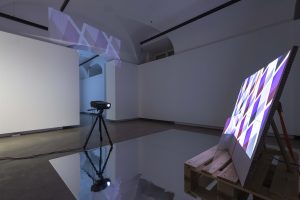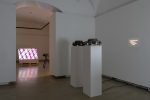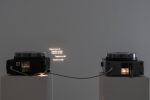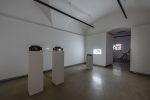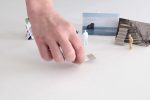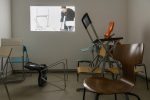re-FORM [again!]
Michaela Schwentner
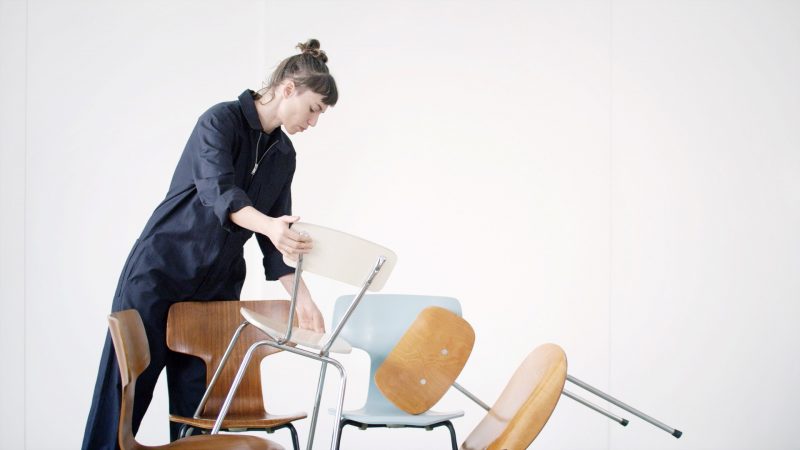
RE-OPENING, 20.5.2020 – 20.06.2020
ARTIST TALK with Michaela Schwentner & Annja Krautgasser, Saturday June 20, 2020 at 17.00 at Neue Galerie. Due to the current COVID-19 regulations a REGISTRATION (office@kuveti.at) is required.
We met with the artist online and talked to her about her exhibition and the situation in Europe.
—————————————–
In her filmic works Michaela Schwentner deals with different spheres of meaning. One of her artistic strategies is to disassemble, unfold, cut up, reflect upon, and break up existing narratives, even the grand narratives, in order to question them and translate them into poetic figures that create new space for thought. In further processes, assemblages of researched and fictional material are updated and re-contextualized and so expanded into the real space.
re-FORM [again!] is both a film and an installation – the title is already a director’s instruction. The text and image material used in its sketched form refer to the absent and its impact: to longing, desire, utopia – here, in the shape of reflections on the development of the Europe that we know, which has inscribed itself into our cultural and economic consciousness, exerting its influence, and to which we still refer. The experimental arrangement consists in negating the filmic structure or opening it out. The scenic does not follow a certain hierarchical order: here, the backdrop, scene, choir, action do not determine each other, they are installed with equal status and rights.
The film-historical and theoretical reference material used in the model-like staging of a film production, as well as the ensuing material, serves as a starting point for her essayistic yet poetic visual language, which she presents on various stages within the gallery space. She weaves diverse narratives into the dramaturgy, including the great narratives of Shakespeare’s dramas and Godard’s political-critical films as well as sociopolitical themes.
The model of the film set is fragmented, inscribed and expanded into the space to equal extents. The individual elements refer to basic principles of scenic production or adaptation (rehearsal, recitation, direction and action instructions, chorus).
Possibilities, therefore, open up the space for different reflections on various levels, culminating in the last room: the instruction and invitation–to re-FORM.
Appearance
appearance:
Everything depends on how you enter
The sentence Everything depends on how you enter makes us think of individual types of appearance, entering a room, stepping onto a stage, stepping into a performance. Here, Michaela Schwentner is also referring to the determinacy of conceivable life plans in general, and to the current hegemonic conditions in Europe.
Room A:
stage:
Curtain
Individual dramatic elements to be seen in the projection of the model film (in Room B) are transferred to Room (A): the curtain from Shakespeare’s The Tempest (behind which Miranda and the stranded Ferdinand are hidden). The artist’s pattern refers to the Commedia dell’arte – travelling (folk) theatre groups whose performances were often subject to censorship or completely prohibited. In doing so, she establishes a historical connection to Austria’s recent political past, in which both – the constitutionally anchored freedom of opinion and public reporting – have been repeatedly subjected to attacks from the right-wing camp.
score:
Miranda, wondering
A whisper behind stage appears as an acoustic level: Curtain up – Miranda from Shakespeare’s The Tempest sings in a whispering voice against the looming catastrophic development in European politics. A commentary on its failure to deal with migration and climate protection. Miranda’s verbal amazement manifests itself in a repeated whisper of the following lines as a motif of hope, of utopia:
O, wonder!
How many goodly creatures are there here! How beauteous mankind is! O brave new world
That has such people in’t!
In 11 takes, these lines are interpreted differently, both formally and in terms of content; the tone changes in the directed repetition, and the delighted amazement turns into criticism, disappointment and finally anger.
Miracles and wonder – we, as part of society, have knowledge and facts and yet we still want to hear “stories” about miracles. We want to be surprised. The miracle carries utopian potential: the unreachable elsewhere, for which all projections aimed at transformation are striving.
Room B:
sequence:
reorient.manifest / a model for a film
The film-historical and theoretical reference material used in the model-like staging of a film production, as well as the ensuing material, serves as a starting point for questions about the appropriation of spaces, roles and perspectives, as well as regarding production and reproduction. In reorient.manifest / model for a film, principles of staging and aspects of the technical are taken up and uncovered, thus directing our view towards image production against the background of more and more rapidly replaced new formats and the difficulties of critical individual judgement. What is true? The framework of the staging, the staging itself is simultaneously truth and manipulation.
The film miniature is the model for a film that never becomes visible in its final form: on the one hand, it remains a projection; on the other, it is a sketch of the scenery construction, referring to the plot by means of a few elements – the history and development of Europe, including instructions for re-orientation and its manifestation.
In the film’s model-like display, different reference points are interlaced with one another in a condensed and poetic form: the Mediterranean as a reference to Europe’s cultural heritage (cultural area, economic area, theatre of war, migration route, consequences of colonial and post-colonial strategies, inadequacy of the so-called European community of values), the storm in Walter Benjamin’s Angel of History, Godard’s Le mépris (first history, love and amazement, then prostitution, the profit motive, and finally disappointment, contempt and separation) and Shakespeare’s The Tempest, the white male hegemony in Europe’s current political activities (right-wing conservative, neoliberal dominance).
Shakespeare saw the basic pattern of all historical processes as a cycle of gaining and losing power. In his plays he shows the “image of eternal history and its unchangeable mechanism”. Michaela Schwentner refers to The Tempest “because here, Shakespeare presents the basic structure of all possible historical sequences or events in a model-like foreshortening on an abstract level, and then repeats them with formulaic consistency. I would like to make these principles even more exemplary and present them in an outlined arrangement that seeks to convey a production’s individual levels and components.”
script:
Chorus 1 + 2
In addition to the model film, its components themselves are also made visible: the projected texts are instruction, narration, construction, poem, image, song, chorus in equal measures. In scripts: Chorus 1 + 2 the levels of meaning of stage direction, dialogue, monologue and chorus are shifted – the script becomes an image. The choruses here are not an affirmation of the dramatic; they are collectives of protagonists actively and reflexively engaged in a dialogue.
Michaela Schwentner
born 1970 in Linz, lives and works in Vienna and Bern.
Schwentner works in the fields of moving image, sound, performance and installation.
Exhibition participation, screenings, performances and residencies:
Centre Pompidou Paris, Manifesta 4 Frankfurt/Main, HKW Berlin, Künstlerhaus Mousonturm Frankfurt, Edith-Russ-House for Media Art Oldenburg, ACF New York, Shedhalle Zurich, CCNOA Brussels, Kiasma Helsinki, Museo Experimental El Eco Mexico City, CCCB Barcelona, UCLA Los Angeles, Kunsthalle Exnergasse Vienna, Kunsthalle Vienna, Secession Vienna, Künstlerhaus Vienna, Kunstverein Graz, Kunsthaus Graz, B3 Biennial of the Moving Image Frankfurt/Main, Sundance Film Festival, Short Film Festival Oberhausen, FIDMarseille, Diagonale Graz, Viennale, Int. Media Art Biennale Wroclaw, Transmediale Berlin, Edinburgh Int. Film Festival, London Int. Film Festival, Vienna Modern, New York Underground Film Festival, Independent Film Festival Rotterdam, European Media Art Festival Osnabrück, Evolution Film Festival Leeds, Cork Film Festival, Chicago Underground Film Festival.
Residencies: subnetAIR Grant + Residency Salzburg, ORTung Hintersee, Embassy of Foreign Artists Geneva, Pixel, Bytes & Film | Artist in Residence ORF III, Egon Schiele Centrum Czesky Krumlov, Guest Studio of the State of Upper Austria in Paliano.
Recent exhibition/project participation:
Video Kabuff: Installation in the context of the spatial intervention Kabuff by Manuel Gorkiewicz, Blickle Raum Spiegelgasse, Vienna
Blickle Archive Series #39: Michaela Schwentner: Blickle Cinema Vienna, Belvedere 21
TRANSFORM She Said: Film series in the context of the exhibition I Cannot Hide My Anger by Monica Bonvicini in the Belvedere 21. Curated by Claudia Slanar and Michaela Schwentner. Blickle Cinema Vienna, Belvedere 21
